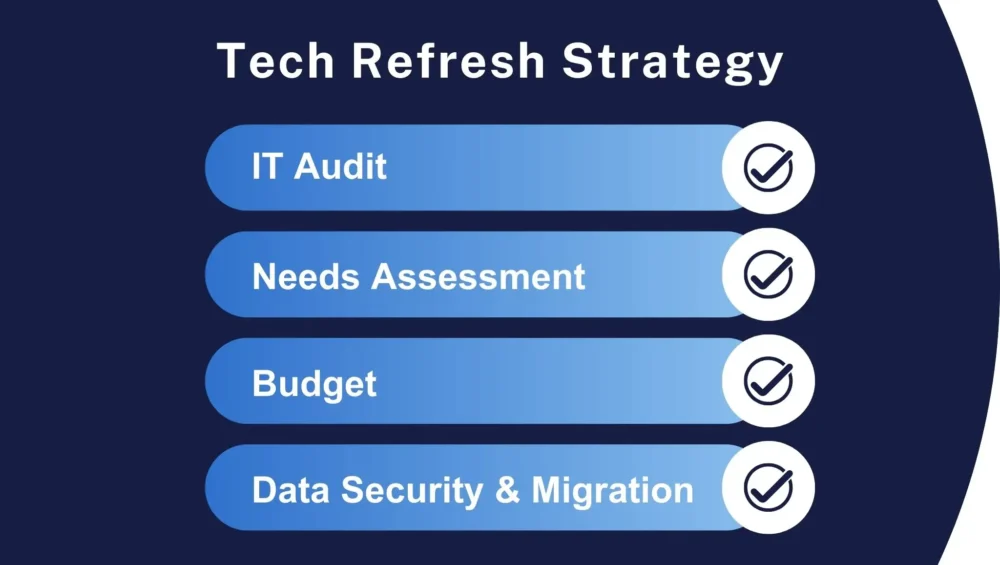The Best Strategies for a Successful Tech Refresh
Like most things in life, nothing lasts forever. And tech is no exception to this. Over time, devices slow down, struggle with new software, and eventually fall short of your business’s growing demands. That’s why organizations need to periodically perform tech refreshes to ensure operational efficiency, enhance security measures, and support future growth opportunities.
In this article, we’ll cover:
- What a tech refresh is
- What makes a tech refresh successful
- Approaches to a tech refresh project
- The best strategies for a successful tech refresh
What Is A Tech Refresh?
A tech refresh, in simple terms, is the process where an organization upgrades its technology in order to stay competitive, scalable, and secure by aligning its IT infrastructure with current demands and future growth plans.
It involves updating hardware, software, networks, and digital tools that have become outdated, unsupported, or no longer meet the business’s needs.
It’s one thing to carry out a tech refresh, and it’s another to make it a successful one.
What Determines a Successful Tech Refresh?
A tech refresh isn’t about getting the latest gadgets just to look modern. It should be driven by clear business goals. Before starting, a company needs to define what it wants to achieve through the process.
In most cases, a successful tech refresh is measured by a few key results:
- Better operational efficiency
- Improved customer experience (like faster response times)
- Higher employee productivity and performance
- Lower operational costs and/or increased revenue
Before we dive into the strategies for a successful tech refresh, let’s discuss the approaches companies can take when performing a tech refresh.
In-House vs. Outsourced Tech Refresh
As the name suggests, an in-house approach means managing the tech refresh using your existing team members. For example, the IT department. Outsourcing, on the other hand, means handing over the tech refresh project to a vendor that specializes in the acquisition and proper disposal of old tech. Different organizations have different needs, so there is no one-size-fits-all approach to managing a tech refresh. Here are factors to consider before you decide to either outsource or manage in-house.
Internal Expertise and Capacity
If your company’s in-house IT team has the necessary skills and experience, and the project won’t collide with their regular duties or stretch them thin, then handling the refresh internally might make sense. But if the workload is too heavy or the expertise isn’t there, outsourcing is the safer, more efficient option.
Project Size and Complexity
Not all tech refreshes are created equal. A small system update might be manageable in-house, but a large-scale, organization-wide overhaul with high stakes and risks calls for external experts who specialize in the field.
Budget Availability
As usual, cost plays a huge role in the final decision. Some businesses find it more affordable to manage the refresh with their existing team, while others prefer to allocate a budget for a third-party service that brings experience and efficiency to the table.
Also, consider the consequences of a tech refresh gone wrong because sometimes upfront costs can cloud judgment of long-term benefits. Many companies also forget that they can sell used IT equipment in bulk, meaning some of the money spent on the tech refresh can be recovered.
Timeline and Urgency
If your business needs the refresh done quickly to avoid downtime or meet new operational demands, outsourcing is the faster option. External providers usually have more resources and experience to hit tight deadlines without compromising quality.
Risk Management
Tech refresh projects come with risks; from potential data loss to system downtime. You need to consider whether the internal team can handle these risks effectively. External vendors often offer service guarantees, warranties, and liability coverage, reducing exposure and risks.
Full Overhaul vs. Phased Upgrade Approach
As mentioned earlier, there’s no one-size-fits-all approach to tech refresh projects. Different companies can take different approaches that best suit their budget and end goal.
A full overhaul means upgrading every piece of old and outdated tech in your organization’s IT environment in one go. A phased approach, on the other hand, refers to updating the tech in stages, usually in an order of most critical to least critical.
A phased tech refresh reduces upfront costs but can drag out timelines and cause compatibility issues between old and new systems, leading to more downtime as opposed to a full overhaul.
To determine the approach of your organization, you should discuss your options with your IT department.
4 Key Strategies for a Successful Tech Refresh
1. Audit and Set Clear Goals
The first step in conducting a tech refresh is to thoroughly audit, assess, and set clear goals for the project. You should:
- Review your current IT infrastructure (networks, current hardware, etc.)
- Identify what’s outdated, and conduct a detailed needs assessment.
- Involve your team by asking them for thoughts.
- Align updates with business objectives.
- Set measurable KPIs to define what success looks like.
2. Plan Smart
Planning smart for your tech refresh goes beyond the tech being replaced itself. It covers proper budgeting, considering a rollout approach, and selecting reliable tech partners. You should:
- Create a realistic budget covering direct and hidden costs.
- Decide between a phased rollout or full overhaul based on your capacity and risk management.
- Partner with reputable vendors who understand your industry and can provide reliable support.
3. Prioritize Data Security
Not prioritizing data security and secure data migration is one of the biggest mistakes we see companies make when refreshing IT assets. It’s a move that can easily go wrong. Here are steps to take:
- Backup data to secure servers with recovery options readily available.
- Develop a secure, well-tested migration plan.
- Migrate data to new devices.
4. Test, Monitor, Train Staff and Optimize Continuously
Testing and monitoring are important to ensure you don’t roll out before you’re ready, and that you can quickly optimize tech for better performance or in case something goes wrong. Also, train staff on how to properly use the new tech. Here’s a step-by-step breakdown:
- Run pilot programs before full deployment
- Monitor system performance and user feedback post-launch
- Train your staff, communicate clearly, and manage change effectively to ensure smooth adoption of new technologies.
- Optimize tech regularly.
- Schedule periodic reviews to keep your tech environment secure, efficient, and future-ready.
Conclusion
A tech refresh isn’t just about swapping out old hardware for newer models, it’s about keeping your business competitive, secure, and ready for what’s next. By taking a strategic approach, defining clear goals, and choosing the right execution method, organizations can minimize risks, maximize returns, and improve overall operational efficiency.
Frequently Asked Questions on Strategies for a Successful Tech Refresh
What is a tech refresh?
A tech refresh is the process of replacing or updating old hardware, software, and digital tools to meet current and future business needs.
How often should a tech refresh be performed?
Most businesses plan a tech refresh every 3 to 5 years, but it depends on the industry, tech type, and business growth. So there’s no one-size-fits-all approach. It’s recommended you consult with a tech refresh vendor to assess your specific business needs.
What is the hardware refresh strategy?
It’s a specific plan for replacing old physical devices (like computers, servers, and networking tools) with newer, more capable ones to avoid downtime and security risks.
What is a good technology strategy?
A good tech strategy aligns IT investments with business goals, focuses on scalability, security, and operational efficiency, and prepares the company for future growth.
How to develop a tech strategy?
Start by assessing current systems, defining business goals, identifying tech needs, setting a budget, and creating a phased or full implementation plan with measurable KPIs.









